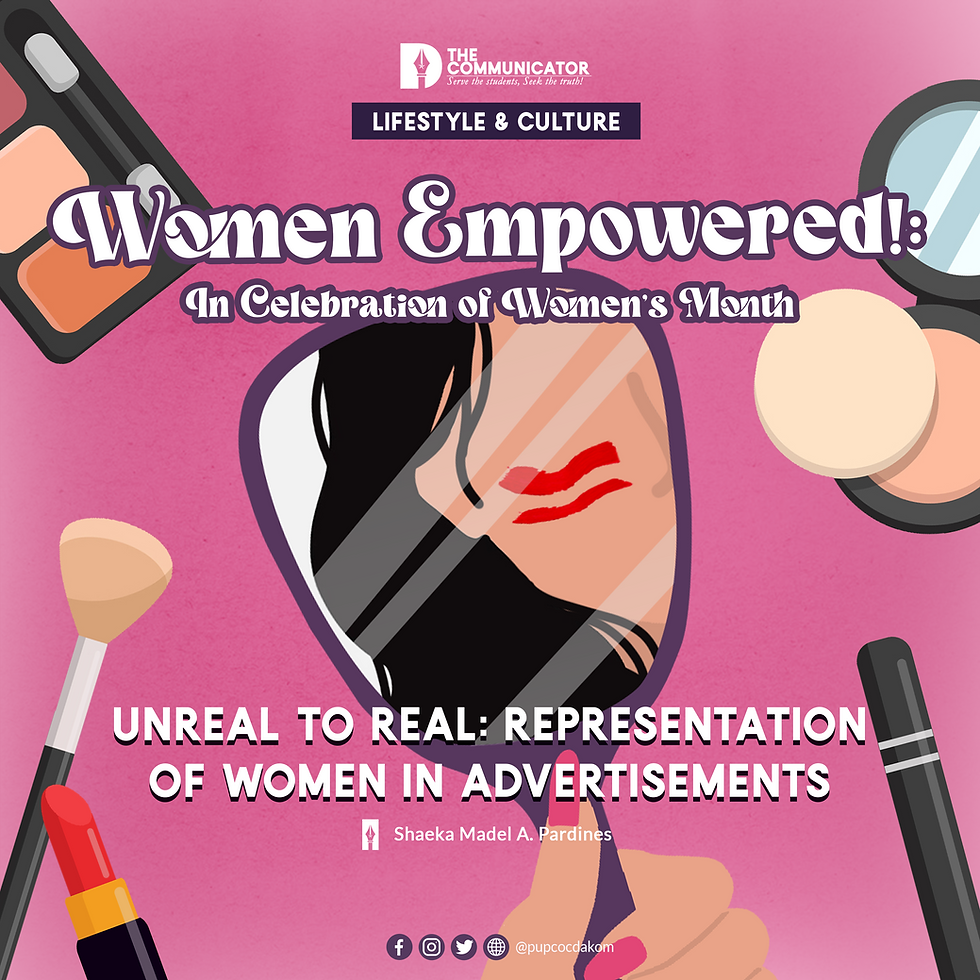LIFESTYLE AND CULTURE | Unreal to Real: Representation of Women in Advertisements
- Shaeka Madel Pardines

- Mar 28, 2023
- 2 min read
For the longest time, advertisements created a space where ideas are limitless—that tends to deceive people and make them believe that these are a reflection of reality as it manifests real scenes, highlights concealed scenarios, and presents shining glamor to attract visions and appraisals. But who do they put in front of the camera? Aren’t these ideal and flawless individuals they constructed? Since when did concealing, filtering, and editing appearances become a reflection of reality? Is it a reflection to say? Or a shadow to play?

The industry’s product is the demand of its superiors—the people. Advertisements are created to present brands in the spotlight differently from consumers' sight; ads' main objective is to promote a product, service, or cause. Due to its strategic way, it created an archetypal lobe that either aims to be truthful or to manipulate, and eventually become the root of unrealistic presentation of products, services, or causes—but this time, it molded the “ideal” she.
The majority of advertisements in print and online media show individuals who have fair skin, are able-bodied, have blonde hair, are wide-legged, and are heterosexual—you name it, everything is about perfection and surrealism. In usual advertisements, a certain product is an answer to certain problems—this may be true, but for the most part, it’s just part of women's existence as humans. It creates unconscious biases and unacceptance of the experiences, characteristics, and appearances women possess.
On the other hand, when people from minority groups do appear on different platforms, there are negative connotations. Discrimination, hate comments, and societal exclusion becomes common when women represent themselves differently than the standards. This just shows that we are living on stereotypical grounds where the “ideal she or her” is only acceptable.
We’re against degrading or throwing shade at the represented women who primarily appeared in online, or print advertisements. In fact, it's an aspiration for some, as it drives them to be better for themselves. However, this becomes a hitch once standards are concretely settled, and it objectifies the value of women in society.
Advertisement has massive power in impacting the decision-making and beliefs of an individual. When done wrong, it can effortlessly manipulate and control the public, especially women, by pointing out their defaults and insecurities due to what they see in advertisements.
Representing the diversity of women in advertisements highly influences women’s acceptance of themselves and empowerment of their capabilities. It gives a sense of security knowing that they are seen and valued by the society they are living in. Showing various, natural, and genuine characteristics of women can immensely affect how they treat womanhood and embrace its beauty.
Challenging the status quo is more high-powered and progressive today than ever before. Different sectors are in harmony in raising our manifestation for embracing, acknowledging, and empowering the representation of diversity amongst women, specifically in advertising.
As future practitioners who will then maneuver the field, may this become a reminder to empower women from the lenses of reality, as someone with uneven skin tone, stretch marks, gray hair, plus size, acne marks, an asymmetrical body, freckles, body hair, and love handles does not lessen the value of women, perhaps it also empowers the viewers as they will perceive that they are being represented by women as well.
Graphics: Alyssa San Diego






Comments